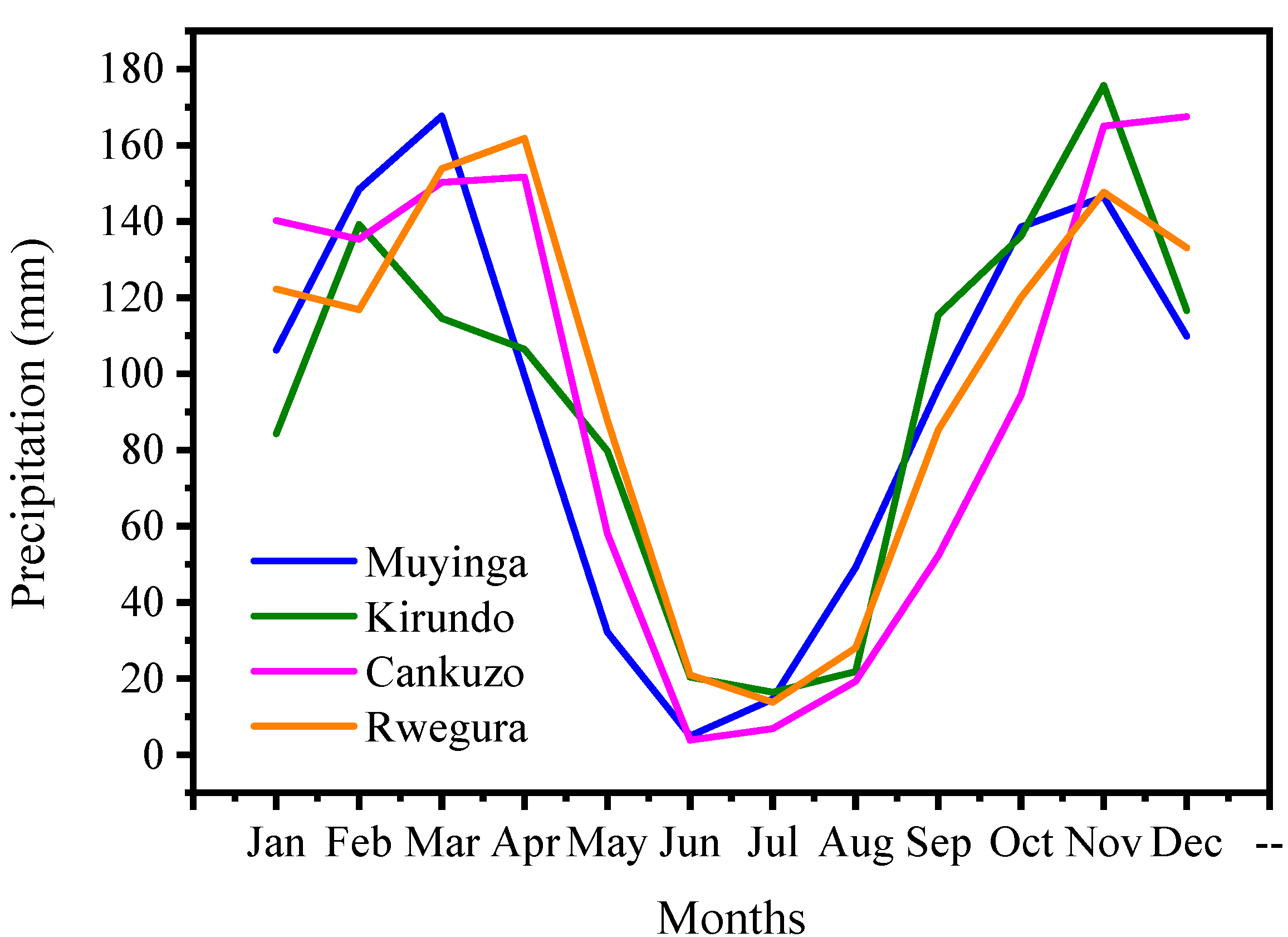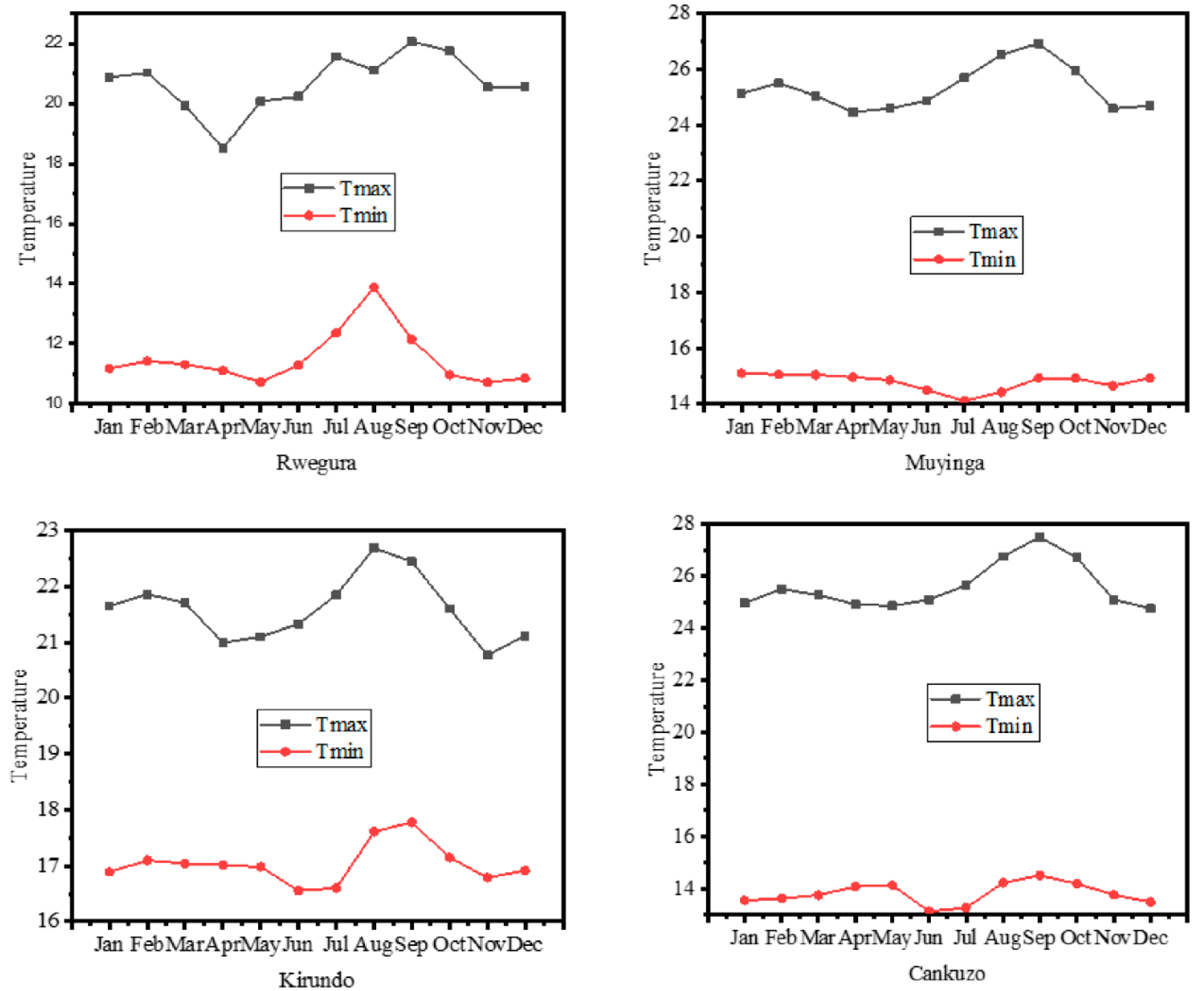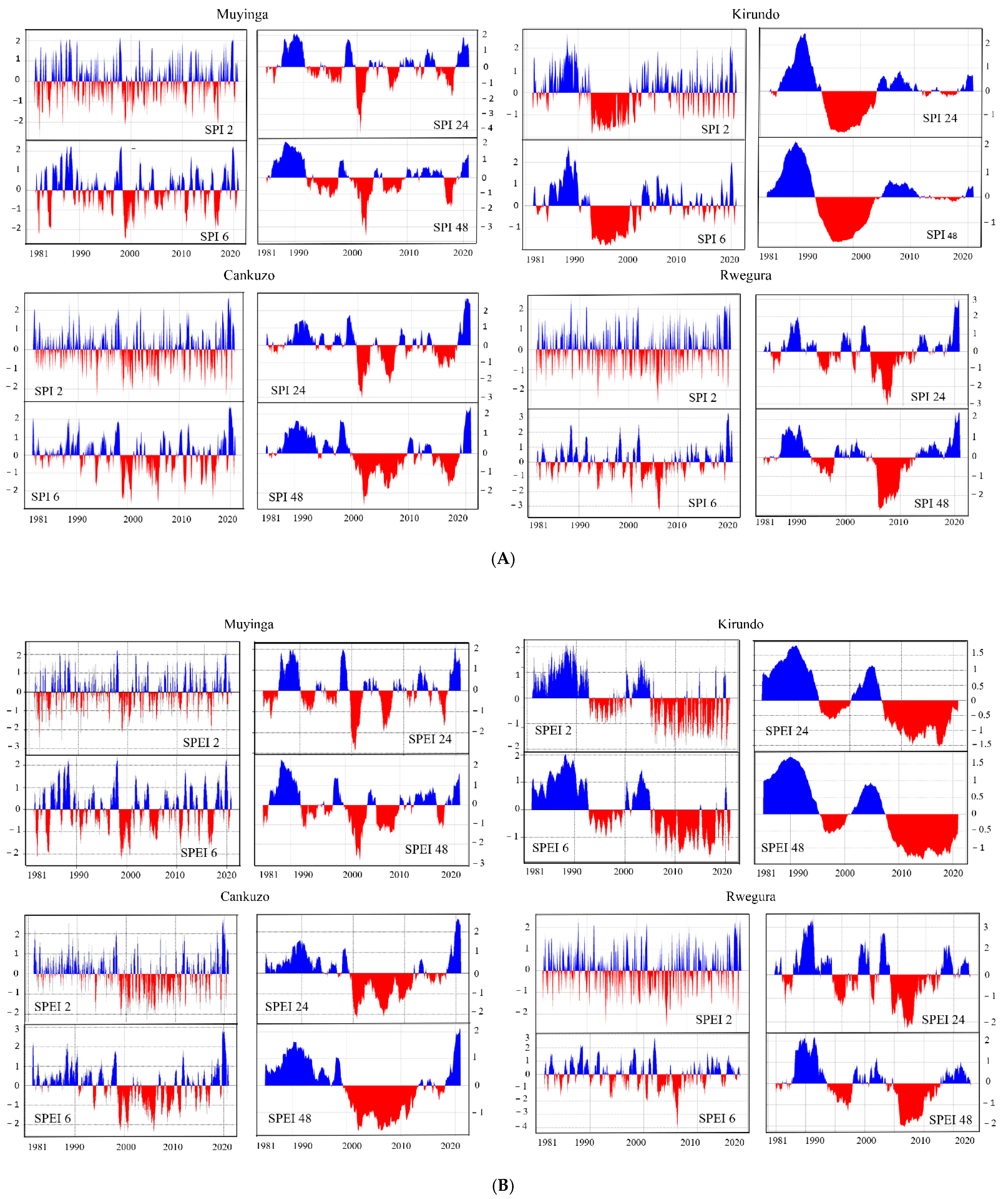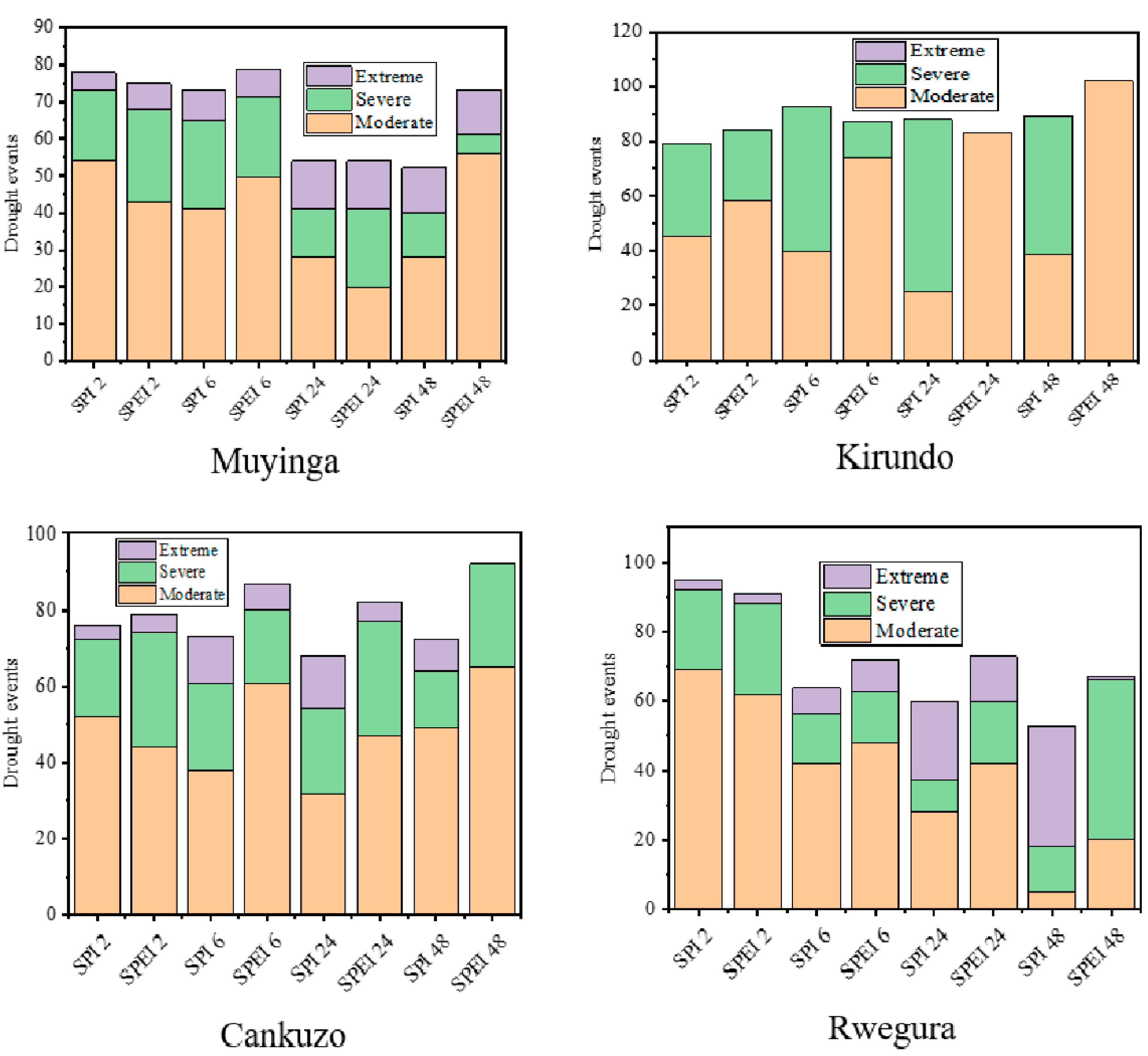Assessment of Two Drought Indices to Quantify and Characterize Drought Incidents: A Case Study of the Northern Part of Burundi
Abstract
:1. Introduction
2. Study Area and Methods
2.1. The Study Area’s Description and Datasets
2.2. Climate and Topography
3. SPEI and SPI Indices of Drought
3.1. SPI
3.2. SPEI
4. Results and Discussion
4.1. Presentation of Temporal Variability of Drought Incidence at Different Timescales
4.2. Characteristics of Drought and Date of Occurrence Patterns
4.3. Evaluation of Drought on Yearly Scales with SPEI and SPI Indices
4.4. The Effectiveness of SPEI and SPI in Identifying Drought Months
5. Conclusions
Author Contributions
Funding
Institutional Review Board Statement
Informed Consent Statement
Data Availability Statement
Acknowledgments
Conflicts of Interest
References
- Maybank, J.; Bonsai, B.; Jones, K.; Lawford, R.; O’Brien, E.G.; Ripley, E.A.; Wheaton, E. Drought as a natural disaster. Atmos. Ocean 1995, 33, 195–222. [Google Scholar] [CrossRef]
- Yusa, A.; Berry, P.; Cheng, J.J.; Ogden, N.; Bonsal, B.; Stewart, R.; Waldick, R. Climate Change, Drought and Human Health in Canada. Int. J. Environ. Res. Public Health 2015, 12, 8359–8412. [Google Scholar] [CrossRef] [PubMed]
- Marengo, J.A.; Cunha, A.P.; Cuartas, L.A.; Deusdará Leal, K.R.; Broedel, E.; Seluchi, M.E.; Michelin, C.M.; de Praga Baião, C.F.; Chuchón Ângulo, E.; Almeida, E.K.; et al. Extreme Drought in the Brazilian Pantanal in 2019–2020: Characterization, Causes, and Impacts. Front. Water 2021, 3, 639204. [Google Scholar] [CrossRef]
- Tijdeman, E.; Menzel, L. The Development and Persistence of Soil Moisture Stress during Drought across Southwestern Germany. Hydrol. Earth Syst. Sci. 2021, 25, 2009–2025. [Google Scholar] [CrossRef]
- Kalisa, W.; Zhang, J.; Igbawua, T.; Kayiranga, A.; Ujoh, F.; Aondoakaa, I.S.; Tuyishime, P.; Li, S.; Simbi, C.H.; Nibagwire, D. Spatial Multi-Criterion Decision Making (SMDM) Drought Assessment and Sustainability over East Africa from 1982 to 2015. Remote Sens. 2021, 13, 5067. [Google Scholar] [CrossRef]
- Otkin, J.A.; Svoboda, M.; Hunt, E.D.; Ford, T.W.; Anderson, M.C.; Hain, C.; Basara, J.B. Flash Droughts: A Review and Assessment of the Challenges Imposed by Rapid-Onset Droughts in the United States. Bull. Am. Meteorol. Soc. 2018, 99, 911–919. [Google Scholar] [CrossRef]
- Tosunoğlu, F.; Onof, C. Joint Modelling of Drought Characteristics Derived from Historical and Synthetic Rainfalls: Application of Generalized Linear Models and Copulas. J. Hydrol. Reg. Stud. 2017, 14, 167–181. [Google Scholar] [CrossRef]
- Fluixá-Sanmartín, J.; Pan, D.; Fischer, L.; Orlowsky, B.; García-Hernández, J.; Jordan, F.; Haemmig, C.; Zhang, F.; Xu, J. Searching for the Optimal Drought Index and Time Scale Combination to Detect Drought: A Case Study from the Lower Jinsha River Basin, China. Hydrol. Earth Syst. Sci. 2018, 22, 889–910. [Google Scholar] [CrossRef] [Green Version]
- Rehana, S.; Sireesha Naidu, G. Development of Hydro-Meteorological Drought Index under Climate Change–Semi-Arid River Basin of Peninsular India. J. Hydrol. 2021, 594, 125973. [Google Scholar] [CrossRef]
- Mckee, T.B.; Doesken, N.J.; Kleist, J. The relation of drought frequency and duration to time scales. In Proceedings of the Eighth Conference Applied Climatology, Anaheim, CA, USA, 17–22 January 1993; Department of Atmospheric Science Colorado State University: Fort Collins, CO, USA, 1993; Volume17, pp. 179–184. [Google Scholar]
- Palmer, W.C. Keeping Track of Crop Moisture Conditions, Nationwide: The New Crop Moisture Index. Weatherwise 1968, 21, 156–161. [Google Scholar] [CrossRef]
- Vicente-Serrano, S.M.; Beguería, S.; López-Moreno, J.I. A Multiscalar Drought Index Sensitive to Global Warming: The Standardized Precipitation Evapotranspiration Index. J. Clim. 2010, 23, 1696–1718. [Google Scholar] [CrossRef] [Green Version]
- Shiru, M.S.; Shahid, S.; Alias, N.; Chung, E.S. Trend Analysis of Droughts during Crop Growing Seasons of Nigeria. Sustainability 2018, 10, 871. [Google Scholar] [CrossRef] [Green Version]
- Nguvava, M.; Abiodun, B.J.; Otieno, F. Projecting Drought Characteristics over East African Basins at Specific Global Warming Levels. Atmos. Res. 2019, 228, 41–54. [Google Scholar] [CrossRef]
- Hao, Y.; Baik, J.; Fred, S.; Choi, M. Comparative Analysis of Two Drought Indices in the Calculation of Drought Recovery Time and Implications on Drought Assessment: East Africa’s Lake Victoria Basin. Stoch. Hydrol. Hydraul. 2021, 36, 1943–1958. [Google Scholar] [CrossRef]
- Ndayiragije, J.M.; Li, F. Monitoring and Analysis of Drought Characteristics Based on the Climate Change in Burundi Using Standardized Precipitation Evapotranspiration Index. Water 2022, 14, 2511. [Google Scholar] [CrossRef]
- Gebremeskel Haile, G.; Tang, Q.; Sun, S.; Huang, Z.; Zhang, X.; Liu, X. Droughts in East Africa: Causes, Impacts and Resilience. Earth Sci. Rev. 2019, 193, 146–161. [Google Scholar] [CrossRef]
- GSURR AFRICA. Strategies for Urbanization and Economic Competitiveness in Burundi. June 2015. Available online: https://documents1.worldbank.org (accessed on 16 August 2022).
- Schneiderbauer, S.; Baunach, D.; Pedoth, L.; Renner, K.; Fritzsche, K.; Bollin, C.; Pregnolato, M.; Zebisch, M.; Liersch, S.; Rivas López, M.D.R.; et al. Spatial-Explicit Climate Change Vulnerability Assessments Based on Impact Chains. Findings from a Case Study in Burundi. Sustainability 2020, 12, 6354. [Google Scholar] [CrossRef]
- Nkunzimana, A.; Shuoben, B.; Guojie, W.; Alriah, M.A.A.; Sarfo, I.; Zhihui, X.; Vuguziga, F.; Ayugi, B.O. Assessment of Drought Events, Their Trend and Teleconnection Factors over Burundi, East Africa. Theor. Appl. Climatol. 2021, 145, 1293–1316. [Google Scholar] [CrossRef]
- Elkollaly, M.; Khadr, M.; Zeidan, B. Drought Analysis in the Eastern Nile Basin Using the Standardized Precipitation Index. Environ. Sci. Pollut. Res. 2018, 25, 30772–30786. [Google Scholar] [CrossRef]
- Kalisa, W.; Zhang, J.; Igbawua, T.; Ujoh, F.; Ebohon, O.J.; Namugije, J.N.; Yao, F. Spatio-Tempoaral Analysis of Drought and Return Periods over the East African Region Using Standardized Precipitation Index from 1920 to 2016. Agric. Water Manag. 2020, 237, 106195. [Google Scholar] [CrossRef]
- Ayugi, B.; Shilenje, Z.W.; Babaousmail, H.; Lim Kam Sian, K.T.C.; Mumo, R.; Dike, V.N.; Iyakaremye, V.; Chehbouni, A.; Ongoma, V. Projected Changes in Meteorological Drought over East Africa Infered from Bias-Adjusted CMIP6 Models. Nat. Hazards 2022, 113, 1151–1176. [Google Scholar] [CrossRef]
- Uwimbabazi, J.; Jing, Y.; Iyakaremye, V.; Ullah, I.; Ayugi, B. Observed Changes in Meteorological Drought Events during 1981–2020 over Rwanda, East Africa. Sustainability 2022, 14, 1519. [Google Scholar] [CrossRef]
- Han, X.; Li, Y.; Yu, W.; Feng, L. Attribution of the Extreme Drought in the Horn of Africa during Short-Rains of 2016 and Long-Rains of 2017. Water 2022, 14, 409. [Google Scholar] [CrossRef]
- Kim, J.-B.; Habimana, J.D.D.; Kim, S.-H.; Bae, D.-H. Assessment of Climate Change Impacts on the Hydroclimatic Response in Burundi Based on Cmip6 Esms. Sustainability 2021, 13, 12037. [Google Scholar] [CrossRef]
- Vicente-Serrano, S.M.; Beguería, S.; Lorenzo-Lacruz, J.; Camarero, J.J.; López-Moreno, J.I.; Azorin-Molina, C.; Revuelto, J.; Morán-Tejeda, E.; Sanchez-Lorenzo, A. Performance of Drought Indices for Ecological, Agricultural, and Hydrological Applications. Earth Interact. 2012, 16, 1–27. [Google Scholar] [CrossRef] [Green Version]
- Liu, C.; Yang, C.; Yang, Q.; Wang, J. Spatiotemporal Drought Analysis by the Standardized Precipitation Index (SPI) and Standardized Precipitation Evapotranspiration Index (SPEI) in Sichuan Province, China. Sci. Rep. 2021, 11, 1–14. [Google Scholar] [CrossRef] [PubMed]
- Tirivarombo, S.; Osupile, D.; Eliasson, P. Drought Monitoring and Analysis: Standardised Precipitation Evapotranspiration Index (SPEI) and Standardised Precipitation Index (SPI). Phys. Chem. Earth 2018, 106, 1–10. [Google Scholar] [CrossRef]
- Nkunzimana, A.; Bi, S.; Jiang, T.; Wu, W.; Abro, M.I. Spatiotemporal Variation of Rainfall and Occurrence of Extreme Events over Burundi during 1960 to 2010. Arab. J. Geosci. 2019, 12, 176. [Google Scholar] [CrossRef]
- Batungwanayo, P.; Vanclooster, M.; Koropitan, A.F. Response of Seasonal Vegetation Dynamics to Climatic Constraints in Northeastern Burundi. J. Geosci. Environ. Prot. 2020, 8, 151–181. [Google Scholar] [CrossRef]
- Niragira, S.; D’Haese, M.; D’Haese, L.; Ndimubandi, J.; Desiere, S.; Buysse, J. Food for Survival: Diagnosing Crop Patterns to Secure Lower Threshold Food Security Levels in Farm Households of Burundi. Food Nutr. Bull. 2015, 36, 196–210. [Google Scholar] [CrossRef] [PubMed]
- Niyongabire, E.; Rhinane, H. Geospatial Techniques Use for Assessment of Vulnerability to Urban Flooding in Bujumbura City, Burundi. ISPRS Int. Arch. Photogramm. Remote Sens. Spat. Inf. Sci. 2019, XLII-4/W12, 147–154. [Google Scholar] [CrossRef] [Green Version]
- Taji, S.G.; Keskar, A.P. Drought Identification and Analysis of Precipitation Trends in Beed District, Maharashtra. Mater. Today Proc. 2021, 61, 332–341. [Google Scholar] [CrossRef]
- Vélez-Nicolás, M.; García-López, S.; Ruiz-Ortiz, V.; Zazo, S.; Molina, J.L. Precipitation Variability and Drought Assessment Using the SPI: Application to Long-Term Series in the Strait of Gibraltar Area. Water 2022, 14, 884. [Google Scholar] [CrossRef]
- Samantaray, A.K.; Ramadas, M.; Panda, R.K. Changes in Drought Characteristics Based on Rainfall Pattern Drought Index and the CMIP6 Multi-Model Ensemble. Agric. Water Manag. 2022, 266, 107568. [Google Scholar] [CrossRef]
- Beguería, S.; Vicente-Serrano, S.M.; Reig, F.; Latorre, B. Standardized Precipitation Evapotranspiration Index (SPEI) Revisited: Parameter Fitting, Evapotranspiration Models, Tools, Datasets and Drought Monitoring. Int. J. Climatol. 2014, 34, 3001–3023. [Google Scholar] [CrossRef] [Green Version]
- Musonda, B.; Jing, Y.; Iyakaremye, V.; Ojara, M. Analysis of Long-Term Variations of Drought Characteristics Using Standardized Precipitation Index over Zambia. Atmosphere 2020, 11, 1268. [Google Scholar] [CrossRef]
- Da Rocha Júnior, R.L.; dos Santos Silva, F.D.; Costa, R.L.; Gomes, H.B.; Pinto, D.D.C.; Herdies, D.L. Bivariate Assessment of Drought Return Periods and Frequency in Brazilian Northeast Using Joint Distribution by Copula Method. Geosciences 2020, 10, 135. [Google Scholar] [CrossRef] [Green Version]
- Henchiri, M.; Igbawua, T.; Javed, T.; Bai, Y.; Zhang, S.; Essifi, B.; Ujoh, F.; Zhang, J. Meteorological Drought Analysis and Return Periods over North and West Africa and Linkage with El Niño–Southern Oscillation (Enso). Remote Sens. 2021, 13, 4730. [Google Scholar] [CrossRef]
- Rolbiecki, R.; Yücel, A.; Kocięcka, J.; Atilgan, A.; Marković, M.; Liberacki, D. Analysis of SPI as Drought Indicator during the Maize Growing Period in the Cukurova Region (Turkey). Sustainability 2022, 14, 3697. [Google Scholar] [CrossRef]
- Stagge, J.H.; Tallasken, L.M.; Xu, C.Y.; Van Lanen, H.A.J. Standardized Precipitation-Evapotranspiration Index (SPEI): Sensitivity to Potential Evapotranspiration Models and Parameters. In Hydrology in a Changing World—Copernicus GmbH (IAHS-AISH Proceedings and Reports); Copernicus Publications: Göttingen, Germany, 2014; pp. 367–373. [Google Scholar]
- Mekonen, A.A.; Berlie, A.B.; Ferede, M.B. Spatial and Temporal Drought Incidence Analysis in the Northeast Highlands of Ethiopia. Geoenviron. Disasters 2020, 7, 10. [Google Scholar] [CrossRef]
- Borona, P.; Busch, F.; Krueger, T.; Rufin, P. Uncertainty in Drought Identification Due to Data Choices, and the Value of Triangulation. Water 2021, 13, 3611. [Google Scholar] [CrossRef]
- Hui-Mean, F.; Yusop, Z.; Yusof, F. Drought Analysis and Water Resources Availability Using Standardized Precipitation Evapotranspiration Index. Atmos. Res. 2018, 201, 102–115. [Google Scholar] [CrossRef]
- Pei, Z.; Fang, S.; Wang, L.; Yang, W. Comparative Analysis of Drought Indicate by the SPI and SPEI at Various Timescales in Inner Mongolia, China. Water 2020, 12, 1925. [Google Scholar] [CrossRef]
- Da Rocha, R.L.; dos Santos Silva, F.D.; Lisboa Costa, R.; Barros Gomes, H.; Luis Herdies, D.; Rodrigues Da Silva, V.D.P.; Candido Xavier, A. Analysis of the Space–Temporal Trends of Wet Conditions in the Different Rainy Seasons of Brazilian Northeast by Quantile Regression and Bootstrap Test. Geosciences 2019, 9, 457. [Google Scholar] [CrossRef] [Green Version]
- Ayugi, B.; Tan, G.; Rouyun, N.; Zeyao, D.; Ojara, M.; Mumo, L.; Babaousmail, H.; Ongoma, V. Evaluation of Meteorological Drought and Flood Scenarios over Kenya, East Africa. Atmosphere 2020, 11, 307. [Google Scholar] [CrossRef] [Green Version]
- Sheffield, J.; Wood, E.F.; Roderick, M.L. Little Change in Global Drought over the Past 60 Years. Nature 2012, 491, 435–438. [Google Scholar] [CrossRef]
- Ogunrinde, A.T.; Olasehinde, D.A.; Olotu, Y. Assessing the Sensitivity of Standardized Precipitation Evapotranspiration Index to Three Potential Evapotranspiration Models in Nigeria. Sci. Afr. 2020, 8, e00431. [Google Scholar] [CrossRef]
- Hargreaves, G.H.; Asce, F.; Allen, R.G. History and Evaluation of Hargreaves Evapotranspiration Equation. J. Irrig. Drain. Eng. 2003, 129, 53–63. [Google Scholar] [CrossRef]
- Gao, X.; Zhao, Q.; Zhao, X.; Wu, P.; Pan, W.; Gao, X.; Sun, M. Temporal and Spatial Evolution of the Standardized Precipitation Evapotranspiration Index (SPEI) in the Loess Plateau under Climate Change from 2001 to 2050. Sci. Total Environ. 2017, 595, 191–200. [Google Scholar] [CrossRef]
- Zhang, R.; Chen, T.; Chi, D. Global Sensitivity Analysis of the Standardized Precipitation Evapotranspiration Index at Different Time Scales in Jilin Province, China. Sustainability 2020, 12, 1713. [Google Scholar] [CrossRef]
- Tadese, M.; Kumar, L.; Koech, R. Long-Term Variability in Potential Evapotranspiration, Water Availability and Drought under Climate Change Scenarios in the Awash River Basin, Ethiopia. Atmosphere 2020, 11, 883. [Google Scholar] [CrossRef]
- Scott, R.L.; Knowles, J.F.; Nelson, J.A.; Gentine, P.; Li, X.; Barron-Gafford, G.; Bryant, R.; Biederman, J.A. Water Availability Impacts on Evapotranspiration Partitioning. Agric. For. Meteorol. 2021, 297, 108251. [Google Scholar] [CrossRef]
- Chang’a, L.B.; Kijazi, A.L.; Luhunga, P.M.; Ng’ongolo, H.K.; Mtongor, H.I. Spatial and Temporal Analysis of Rainfall and Temperature Extreme Indices in Tanzania. Atmos. Clim. Sci. 2017, 7, 525–539. [Google Scholar] [CrossRef] [Green Version]
- Nkurunziza, I.F.; Guirong, T.; Paul Ngarukiyimana, J.; Sindikubwabo, C.; Nasim, W.; Sori Gomez, R.; Ayugi, B.; Ngarukiyimana, J.P. Open Access Nkurunziza et al Influence of the Mascarene High on October-December Rainfall and Their Associated Atmospheric Circulation Anomalies over Rwanda. J. Environ. Agric. Sci. 2019, 20, 1–20. [Google Scholar]
- Polong, F.; Chen, H.; Sun, S.; Ongoma, V. Temporal and Spatial Evolution of the Standard Precipitation Evapotranspiration Index (SPEI) in the Tana River Basin, Kenya. Theor. Appl. Climatol. 2019, 138, 777–792. [Google Scholar] [CrossRef]






| Station | Latitude | Longitude | Elevation (m) | Type of Data | Length |
|---|---|---|---|---|---|
| Muyinga | −2.85 | 30.35 | 1756 | Rainfall &Temperature | 1981–2020 |
| Kirundo | −2.58 | 30.11 | 1449 | Rainfall & Temperature | 1981–2020 |
| Cankuzo | −3.31 | 30.53 | 1652 | Rainfall & Temperature | 1981–2020 |
| Rwegura | −2.91 | 29.51 | 2302 | Rainfall & Temperature | 1981–2020 |
| Categories | SPI, SPEI |
|---|---|
| Extremely wet | 2 |
| Severely wet | 1.5–1.99 |
| Moderately wet | 1–1.49 |
| Near normal | −0.99 to −0.99 |
| Moderately dry | −1 to −1.19 |
| Severely dry | −1.5 to −1.99 |
| Extremely dry | 2 |
| Stations | SPI Index | Date of Occurrence | Duration (Month) | Severity | Intensity | Category |
|---|---|---|---|---|---|---|
| Muyinga | SPI 2 | October 1998–January 1999 | 4 | −8.00 | −2.00 | Extreme |
| June 2002–Sepember 2002 | 4 | −4.85 | −1.21 | Moderate | ||
| July 2010–October 2010 | 4 | −5.06 | −1.26 | Moderate | ||
| SPI 6 | December 1993–July 1994 | 8 | −13.53 | −1.67 | Severe | |
| August 1998–October 1999 | 15 | −25.72 | −1.72 | Severe | ||
| April 2000–October 2000 | 7 | −10.83 | −1.55 | Severe | ||
| August 2010–December 2010 | 5 | −7.55 | −1.51 | Severe | ||
| April 2016–March 2017 | 12 | −17.50 | −1.46 | Moderate | ||
| SPI 24 | November 1999–August 2001 | 22 | −52.80 | −2.4 | Severe | |
| February 2010–October 2010 | 9 | −12.30 | −1.37 | Moderate | ||
| November 2016–January 2018 | 15 | −19.73 | −1.31 | Moderate | ||
| SPI 48 | November 2001–August 2003 | 22 | −45.43 | −2.06 | Severe | |
| November 2016–February 2018 | 16 | − 24.15 | −1.51 | Severe | ||
| Kirundo | SPI 2 | August 1992–May 1993 | 10 | −14.22 | −1.42 | Moderate |
| SPI 6 | October 1993–January 1998 | 52 | −73.70 | −1.42 | Moderate | |
| November 1992–January 2000 | 87 | −132.50 | −1.53 | Severe | ||
| January 2001–June 2001 | 6 | −7.07 | −1.20 | Moderate | ||
| SPI 24 | October 1993–January 2001 | 88 | −136.13 | −1.55 | Severe | |
| SPI 48 | November 1994–April 2002 | 90 | −134.65 | −1.50 | Severe | |
| Cankuzo | SPI 2 | September 1993–November 1993 | 3 | −5.05 | −1.68 | Severe |
| August 2000–October 2000 | 3 | −5.00 | −1.66 | Severe | ||
| September 2005–December 2005 | 4 | −6.82 | −1.70 | Severe | ||
| January 2012–March 2012 | 3 | −4.47 | −1.50 | Severe | ||
| SPI 6 | October 1993–December 1993 | 3 | −4.90 | −1.63 | Severe | |
| November 1998–July 1999 | 9 | −18.00 | −2.00 | Extreme | ||
| April 2000–November 2000 | 8 | −15.24 | −1.90 | Severe | ||
| June 2005–February 2006 | 9 | −15.44 | −1.72 | Severe | ||
| January 2011–May 2011 | 5 | −8.40 | −1.68 | Severe | ||
| April 2014–September 2014 | 6 | −8.50 | −1.42 | Moderate | ||
| SPI 24 | December 1999–March 2002 | 28 | −52.76 | −1.88 | Severe | |
| January 2005–October 2006 | 22 | −36.55 | −1.66 | Severe | ||
| January 2015–December 2015 | 12 | −13.82 | −1.15 | Moderate | ||
| SPI 48 | November 2001–April 2003 | 18 | −32.50 | −1.81 | Severe | |
| August 2005–December 2007 | 29 | −40.00 | −1.40 | Moderate | ||
| October 2016–February 2018 | 17 | −22.81 | −1.34 | Moderate | ||
| Rwegura | SPI 2 | July 2002–November 2002 | 5 | −6.54 | −1.30 | Moderate |
| September 2005–February 2006 | 6 | −11.00 | −1.83 | Severe | ||
| SPI 6 | May 2000–October 2000 | 6 | −11.08 | −1.85 | Severe | |
| July 2002–March 2003 | 9 | −12.00 | −1.33 | Moderate | ||
| September 2005–June 2006 | 10 | −24.70 | −2.47 | Severe | ||
| SPI 24 | May 1994–November 1994 | 7 | −7.72 | −1.10 | Moderate | |
| January 2004–November 2004 | 11 | −17.35 | −1.58 | Severe | ||
| September 2005–January 2008 | 29 | −64.00 | −2.20 | Extreme | ||
| SPI 48 | November 2005–December 2009 | 50 | −108.00 | −2.10 | Extreme |
| Stations | SPEI Index | Date of Occurrence | Duration (Month) | Severity | Intensity | Category |
|---|---|---|---|---|---|---|
| Muyinga | SPEI 2 | August 1982–October 1982 | 3 | −4.66 | −1.55 | Severe |
| January 1984–March 1984 | 3 | −4.67 | −1.55 | Severe | ||
| October 1998–January 1999 | 4 | −8.11 | −2.03 | Extreme | ||
| April 2000–August 2000 | 5 | −7.30 | −1.46 | Moderate | ||
| SPEI 6 | November 1983–July 1984 | 9 | −14.32 | −1.60 | Severe | |
| August 1998–October 1999 | 11 | −19.36 | −1.76 | Severe | ||
| April 2000–October 2000 | 7 | −11.70 | −1.67 | Severe | ||
| August 2010–December 2010 | 5 | −6.71 | −1.34 | Moderate | ||
| May 2016–April 2017 | 12 | −16.06 | −1.33 | Moderate | ||
| SPEI 24 | November 1999–August 2001 | 23 | −48.21 | −2.10 | Extreme | |
| December 2005–May 2007 | 18 | −27.32 | −1.52 | Severe | ||
| June 2017–January 2018 | 8 | −10.86 | −1.35 | Moderate | ||
| SPEI 48 | March 2001–May 2003 | 23 | −49.40 | −2.15 | Severe | |
| January 2006–December 2008 | 36 | −43.00 | −1.20 | Moderate | ||
| Kirundo | SPEI 2 | July 2010–December 2010 | 6 | −8.13 | −1.35 | Moderate |
| June 2014–August 2014 | 4 | −5.48 | −1.37 | Moderate | ||
| July 2015–October 2015 | 4 | −5.43 | −1.35 | Moderate | ||
| June 2016–October 2016 | 5 | −7.67 | −1.53 | Moderate | ||
| April 2020–July 2020 | 4 | −6.00 | −1.50 | Moderate | ||
| SPEI 6 | August 2010–November 2011 | 16 | −22.09 | −1.40 | Moderate | |
| June 2016–December 2017 | 19 | −25.70 | −1.35 | Moderate | ||
| SPEI 24 | May 2009–October 2014 | 61 | −62.72 | −1.03 | Moderate | |
| September 2016–August 2018 | 24 | −32.26 | −1.34 | Moderate | ||
| SPEI 48 | November 1994–April 2002 | 105 | −120.9 | −1.15 | Moderate | |
| Cankuzo | SPEI 2 | November 1998–October 1999 | 4 | −6.72 | −1.68 | Severe |
| April 2010–October 2010 | 7 | −10.87 | −1.55 | Moderate | ||
| July 2005–December 2005 | 6 | −10.36 | −1.73 | Severe | ||
| SPEI 6 | January 1999–July 1999 | 7 | −13.20 | −1.88 | Severe | |
| February 2000–December 2000 | 11 | −18.04 | −1.64 | Severe | ||
| February 2005–April 2006 | 15 | −24.38 | −1.63 | Severe | ||
| August 2008–December 2008 | 5 | −7.72 | −1.54 | Severe | ||
| January 2011–May 2011 | 5 | −7.10 | −1.42 | Moderate | ||
| SPEI 24 | December 1999–March 2002 | 28 | −44.16 | −1.60 | Severe | |
| May 2004–December 2006 | 32 | −50.60 | −1.60 | Severe | ||
| November 2008–March 2010 | 17 | −21.30 | −1.25 | Moderate | ||
| SPEI 48 | January 2002–March 2004 | 27 | −35.00 | −1.30 | Moderate | |
| January 2005–November 2009 | 61 | −83.00 | −1.40 | Moderate | ||
| January 2011–June 2011 | 6 | −7.02 | −1.20 | Moderate | ||
| Rwegura | SPEI 2 | September 1993–November 1993 | 3 | −5.20 | −1.73 | Severe |
| September 2005–April 2006 | 8 | −14.00 | −1.75 | Severe | ||
| SPEI 6 | September 1993–March 1994 | 7 | −11.02 | −1.57 | Severe | |
| May 2000–October 2000 | 6 | −11.00 | −1.83 | Severe | ||
| July 2002–March 2003 | 9 | −12.00 | −1.33 | Moderate | ||
| June 2005–December 2006 | 19 | −38.00 | −2.00 | Extreme | ||
| March 2011–July 2011 | 5 | −6.00 | −1.20 | Moderate | ||
| SPEI 24 | April 1994–August 1995 | 17 | −20.30 | −1.20 | Moderate | |
| May 2000–October 2000 | 6 | −7.32 | −1.22 | Moderate | ||
| December 2003–December 2007 | 49 | −81.30 | −1.66 | Severe | ||
| SPEI 48 | October 1996–August 1997 | 11 | −12.43 | −1.13 | Moderate | |
| November 2005–December 2009 | 51 | −89.10 | −1.75 | Severe |
Publisher’s Note: MDPI stays neutral with regard to jurisdictional claims in published maps and institutional affiliations. |
© 2022 by the authors. Licensee MDPI, Basel, Switzerland. This article is an open access article distributed under the terms and conditions of the Creative Commons Attribution (CC BY) license (https://creativecommons.org/licenses/by/4.0/).
Share and Cite
Ndayiragije, J.M.; Li, F.; Nkunzimana, A. Assessment of Two Drought Indices to Quantify and Characterize Drought Incidents: A Case Study of the Northern Part of Burundi. Atmosphere 2022, 13, 1882. https://doi.org/10.3390/atmos13111882
Ndayiragije JM, Li F, Nkunzimana A. Assessment of Two Drought Indices to Quantify and Characterize Drought Incidents: A Case Study of the Northern Part of Burundi. Atmosphere. 2022; 13(11):1882. https://doi.org/10.3390/atmos13111882
Chicago/Turabian StyleNdayiragije, Jean Marie, Fan Li, and Athanase Nkunzimana. 2022. "Assessment of Two Drought Indices to Quantify and Characterize Drought Incidents: A Case Study of the Northern Part of Burundi" Atmosphere 13, no. 11: 1882. https://doi.org/10.3390/atmos13111882
APA StyleNdayiragije, J. M., Li, F., & Nkunzimana, A. (2022). Assessment of Two Drought Indices to Quantify and Characterize Drought Incidents: A Case Study of the Northern Part of Burundi. Atmosphere, 13(11), 1882. https://doi.org/10.3390/atmos13111882






